Space Settlements
By Fred Scharmen
Columbia Books on Architecture and the City
$24.00
The Earth is finite, and the sky is limitless. So proposed Princeton physicist Gerard O’Neill during the convening of the NASA Summer Study in 1975, when O’Neill gathered engineers, architects, astrophysicists, and others to flesh out logistics for the space settlements originally conceived by his students. With fears of resource shortages and overpopulation dominating the 1970s, O’Neill, his students, and prominent science fiction authors proposed massive rotating spaceborne structures that could perpetuate humanity among the stars.
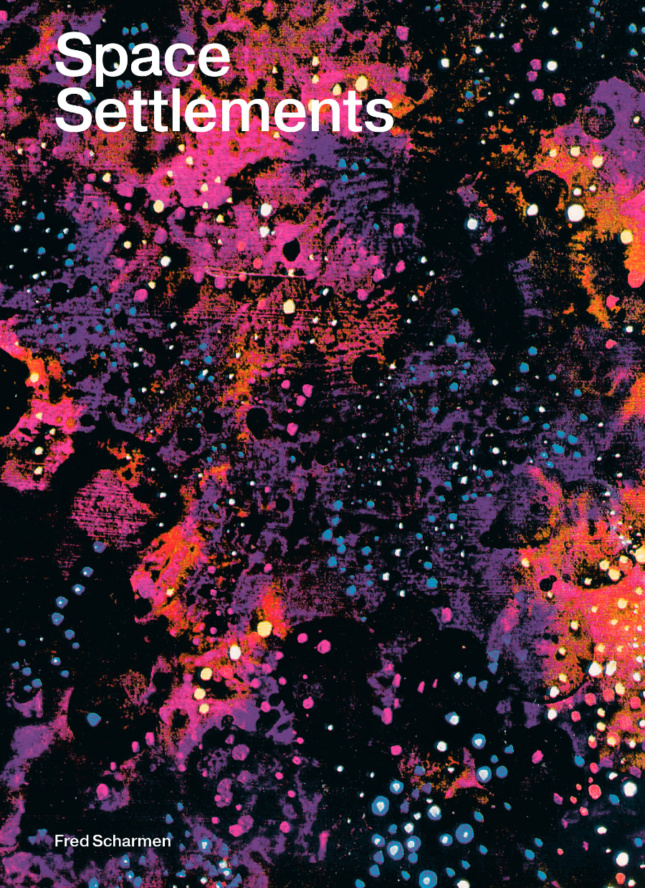
Of course, as Fred Scharmen meticulously documents in Space Settlements, that’s easier said than done. How can humans make the leap to living in pastoral orbital colonies when every artificial biosphere on Earth has failed? How would placemaking work in a wholly artificial environment, where every vista must be carefully curated as to not alienate inhabitants? What is the “ground,” normally a constant constraint to push against, in a habitat where even that is constructed? Scharmen’s book starts as a history of the creation and impact of a series of Summer Study paintings from artists Rick Guidice and Don Davis, but it quickly turns into a deeper examination of what it means to exist outside of Earth’s atmosphere. If building vertically allows architects to imagine new spaces unconstrained by the ground plane, as Rem Koolhaas proclaimed in Delirious New York, then building in space presents designers with the ultimate freedom—while ironically constraining them with the most stringent challenges.
The images that emerged from the Summer Study are, by design, both familiar and alien. They show pastoral landscapes and familiar building typologies curved around the interior of massive toroidal or spherical spaceships, rotating to create artificial gravity at their edges. While O’Neill emphasized the need to consider these settlements as places with logistical needs and eschewed flashy pop culture depictions of his work, Guidice and Davis knew that illustrating the space stations as occupiable places would drum up public interest for the research. These megastructures, half-a-mile wide or wider with names like O’Neill Cylinders, Bernal Spheres, and Stanford Tori, would be anchored into orbits or Lagrange Points—places where the gravitational pull from the Earth and the Moon were equal, meaning whatever’s put there, stays there.
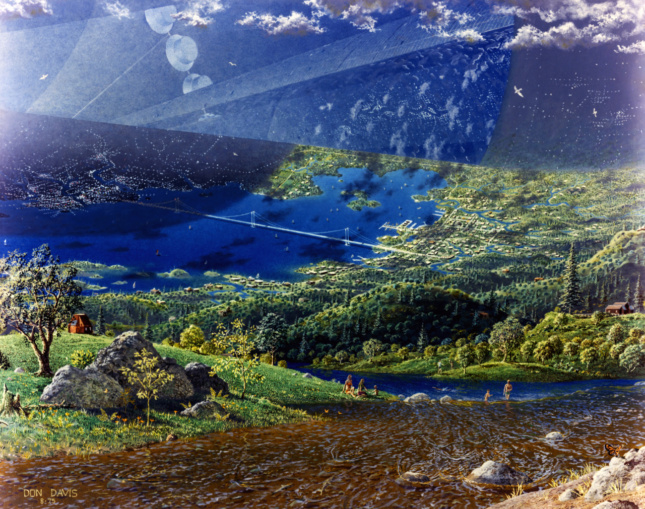
That imagery is still powerful 40 years later. With the fears of the ’70s once again resurgent as climate change, resource shortages, and mass migration dominate the headlines, billionaires are looking for ways to leave this world behind and move to the stars. Take the Jeff Bezos–founded Blue Origin, a spaceflight and rocketry company founded by the world’s richest man for the express purpose of eventually moving humanity off this planet. In May of this year, the company released a suite of renderings of spacefaring toroidal colonies, each depicting idyllic countrysides and architectural pastiches protected by a glass-enclosed sky, clear references to the Summer Study images from 40 years prior. The renderings were created to gin up excitement—and financial backing—for extracting resources from the moon as the first phase of launching an extraterrestrial settlement, but exactly what’s depicted has a deeper significance.
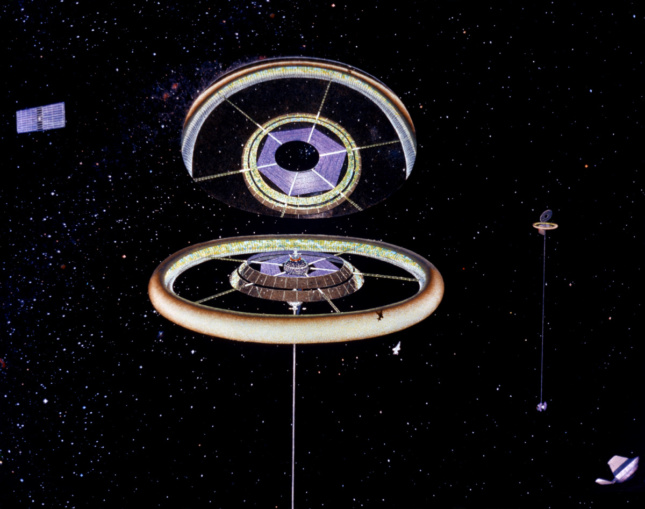
Scharmen devotes much of Space Settlements to the human considerations of living in space. Humans, like all animals, need certain things to thrive, including open space and greenery, and the opportunity to watch something grow; hence the abundance of agricultural landscapes and wide vistas in Davis’s, Guidice’s, and Blue Origin’s images. However, as Scharmen points out (and landscape architect Marc Miller highlighted in an online article for AN), the renderings are very conscious throwbacks to Hudson River School paintings. These paintings were intended, in part, to encourage white observers to move west and assert their dominance over the North American wilderness. In depicting their landscapes as (artificial) wildernesses to be tamed, Blue Origin is trying to entice a very specific, well-educated population to “settle” these massive structures.
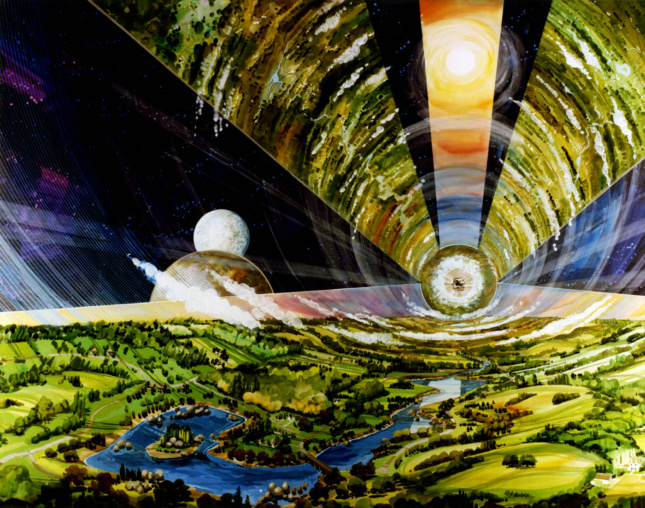
Therein lies the rub. Both the Summer Study artists and O’Neill knew that their depictions of leisure were a bit misleading, as all colonists would have to work hard to keep their city-in-the-sky running even with advanced automation. More importantly, the rationale behind expanding into these megastructures in the first place is rooted in an outgrowth of extractive capitalism. As Scharmen and O’Neill both discuss in the book, and as the Earth-bound billionaires of today surely know, space outposts would have to justify their immense cost, likely through extraterrestrial mineral mining.
However, go one level deeper, and the implications become even darker. As Bezos and his peers have repeatedly stated, they feel that the only way to “save” humanity from our doomed planet is to expand into space. Bezos frequently claims that he has too much money to spend on Earth and that expanding into space is the only logical next step.
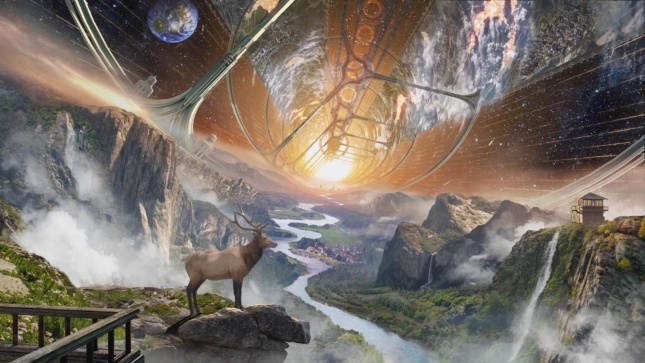
“The solar system can easily support a trillion humans,” Bezos told Business Insider. “And if we had a trillion humans, we would have a thousand Einsteins and a thousand Mozarts and unlimited, for all practical purposes, resources and solar power.”
To say that entirely artificial and dangerous habitats are the next logical step in humankind’s progression presupposes that this planet, one that we evolved specifically to inhabit, is already full. What was once proposed as a way to foster unique communities in the sky and expand humanity’s consciousness beyond the borders of this world has taken on a nihilist tinge. No one else has summed it up better than Elon Musk, another stargazing tech billionaire. When asked why he wanted to settle other planets in an interview with Aeon, Musk famously replied, “Fuck Earth! Who cares about Earth?”











